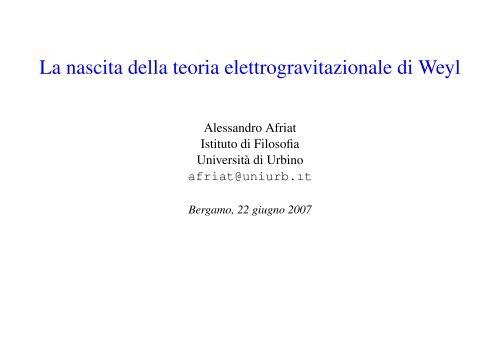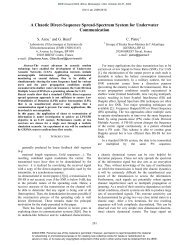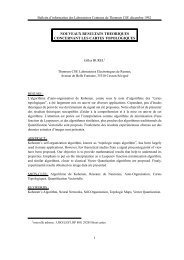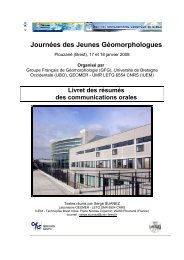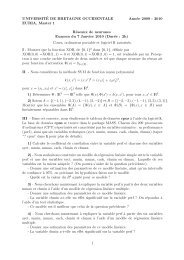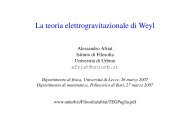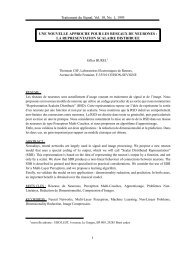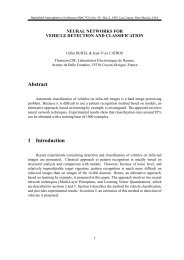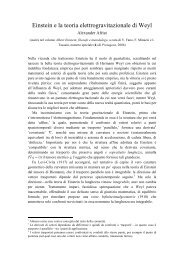La nascita della teoria elettrogravitazionale di Weyl
La nascita della teoria elettrogravitazionale di Weyl
La nascita della teoria elettrogravitazionale di Weyl
You also want an ePaper? Increase the reach of your titles
YUMPU automatically turns print PDFs into web optimized ePapers that Google loves.
<strong>La</strong> <strong>nascita</strong> <strong>della</strong> <strong>teoria</strong> <strong>elettrogravitazionale</strong> <strong>di</strong> <strong>Weyl</strong><br />
Alessandro Afriat<br />
Istituto <strong>di</strong> Filosofia<br />
Università <strong>di</strong> Urbino<br />
afriat@uniurb.ıt<br />
Bergamo, 22 giugno 2007
Tesi<br />
• la <strong>teoria</strong> <strong>elettrogravitazionale</strong> (TEG) <strong>di</strong> <strong>Weyl</strong> uscì dalla ‘giustizia matematica,’<br />
ossia dalla ‘parità’ <strong>di</strong> <strong>di</strong>rezione e lunghezza (PDL: un vettore è fatto <strong>di</strong> <strong>di</strong>rezione<br />
e lunghezza; le due caratteristiche dovevano godere degli stessi <strong>di</strong>ritti, anzi delle<br />
stesse libertà)<br />
Teoria <strong>elettrogravitazionale</strong> <strong>di</strong> <strong>Weyl</strong> 2
Ryckman<br />
• prendo le mosse dal libro<br />
The reign of relativity: Philosophy in physics 1915-1925<br />
(Oxford University Press 2005)<br />
<strong>di</strong> Thomas Ryckman<br />
• propongo una <strong>di</strong>versa ricostruzione <strong>della</strong> genesi <strong>della</strong> TEG<br />
Teoria <strong>elettrogravitazionale</strong> <strong>di</strong> <strong>Weyl</strong> 3
Ryckman<br />
• prendo le mosse dal libro<br />
The reign of relativity: Philosophy in physics 1915-1925<br />
(Oxford University Press 2005)<br />
<strong>di</strong> Thomas Ryckman<br />
• propongo una <strong>di</strong>versa ricostruzione <strong>della</strong> genesi <strong>della</strong> TEG<br />
Teoria <strong>elettrogravitazionale</strong> <strong>di</strong> <strong>Weyl</strong> 3
Unificazione voluta?<br />
• viene quasi sempre sostenuto (da Folland, Trautman, Perlick, Vizgin ed altri) che<br />
l’unificazione <strong>di</strong> gravitazione ed elettromagnetismo raggiunta nella <strong>teoria</strong> <strong>di</strong><br />
<strong>Weyl</strong> fosse voluta<br />
• la <strong>teoria</strong> scaturì invece, come hanno scritto Bergia e Ryckman, da considerazioni<br />
aprioristiche<br />
Teoria <strong>elettrogravitazionale</strong> <strong>di</strong> <strong>Weyl</strong> 4
Unificazione voluta?<br />
• viene quasi sempre sostenuto (da Folland, Trautman, Perlick, Vizgin ed altri) che<br />
l’unificazione <strong>di</strong> gravitazione ed elettromagnetismo raggiunta nella <strong>teoria</strong> <strong>di</strong><br />
<strong>Weyl</strong> fosse voluta<br />
• la <strong>teoria</strong> scaturì invece, come hanno scritto Bergia e Ryckman, da considerazioni<br />
aprioristiche<br />
Teoria <strong>elettrogravitazionale</strong> <strong>di</strong> <strong>Weyl</strong> 4
“Gravitation und Elektrizität”<br />
Sitzungsber. d. K. Preuß. Akad. d. Wissenschaften 1918, p.465<br />
Indem man <strong>di</strong>e erwähnte Inkonsequenz beseitigt, kommt eine Geometrie zustande, <strong>di</strong>e<br />
überraschenderweise , auf <strong>di</strong>e Welt angewendet, nicht nur <strong>di</strong>e Gravitationserscheinungen,<br />
sondern auch <strong>di</strong>e des elektromagnetischen Feldes erklärt.<br />
Teoria <strong>elettrogravitazionale</strong> <strong>di</strong> <strong>Weyl</strong> 5
Einstein a <strong>Weyl</strong>, 10 <strong>di</strong>cembre 1918<br />
Übrigens müssen Sie nicht glauben, daß ich von der Physik her dazu gekommen bin,<br />
neben der quadratische noch <strong>di</strong>e lineare Differentialform in <strong>di</strong>e Geometrie<br />
einzuführen; sondern ich wollte wirklich <strong>di</strong>ese “Inkonsequenz,” <strong>di</strong>e mir schon immer<br />
ein Dorn im Auge gewesen war, endlich einmal beseitigen und bemerkte dann zu<br />
meinem eigenen Erstaunen: das sieht so aus, als erklärt es <strong>di</strong>e Elektrizität.<br />
Teoria <strong>elettrogravitazionale</strong> <strong>di</strong> <strong>Weyl</strong> 6
Ma da quali considerazioni aprioristiche uscì la TEG?<br />
• due can<strong>di</strong>dati:<br />
1. Ryckman riconduce la TEG a un programma ‘infinitesimale’ con ra<strong>di</strong>ci<br />
husserliane<br />
2. io appunto la riconduco alla parità <strong>di</strong> <strong>di</strong>rezione e lunghezza<br />
Teoria <strong>elettrogravitazionale</strong> <strong>di</strong> <strong>Weyl</strong> 7
Ma da quali considerazioni aprioristiche uscì la TEG?<br />
• due can<strong>di</strong>dati:<br />
1. Ryckman riconduce la TEG a un programma ‘infinitesimale’ con ra<strong>di</strong>ci<br />
husserliane<br />
2. io appunto la riconduco alla parità <strong>di</strong> <strong>di</strong>rezione e lunghezza<br />
Teoria <strong>elettrogravitazionale</strong> <strong>di</strong> <strong>Weyl</strong> 7
Perché ricondurre la TEG alla parità <strong>di</strong> <strong>di</strong>rezione e lunghezza?<br />
• sorprendentemente la PDL è logicamente sufficiente (per la derivazione <strong>di</strong> quasi<br />
tutta la TEG), mentre il programma infinitesimale, così come compare nel 1918,<br />
è troppo vago per esserlo<br />
• la PDL ha una presenza maggiore, più evidente, nel contesto <strong>della</strong> scoperta—in<br />
cui il programma infinitesimale compare solo nella forma <strong>di</strong> qualche accenno, <strong>di</strong><br />
un paio <strong>di</strong> slogan, senza motivazione né fondamento<br />
• il programma infinitesimale prenderà corpo solo negli anni a venire, in un<br />
successivo ‘contesto <strong>della</strong> giustificazione,’ in cui verrà appunto giustificato e<br />
motivato come ‘telescetticismo’ retto da una sottile epistemologia che Ryckman<br />
riconduce a Husserl e che porta alla delegittimazione dei confronti a <strong>di</strong>stanza<br />
Teoria <strong>elettrogravitazionale</strong> <strong>di</strong> <strong>Weyl</strong> 8
Perché ricondurre la TEG alla parità <strong>di</strong> <strong>di</strong>rezione e lunghezza?<br />
• sorprendentemente la PDL è logicamente sufficiente (per la derivazione <strong>di</strong> quasi<br />
tutta la TEG), mentre il programma infinitesimale, così come compare nel 1918,<br />
è troppo vago per esserlo<br />
• la PDL ha una presenza maggiore, più evidente, nel contesto <strong>della</strong> scoperta—in<br />
cui il programma infinitesimale compare solo nella forma <strong>di</strong> qualche accenno, <strong>di</strong><br />
un paio <strong>di</strong> slogan, senza motivazione né fondamento<br />
• il programma infinitesimale prenderà corpo solo negli anni a venire, in un<br />
successivo ‘contesto <strong>della</strong> giustificazione,’ in cui verrà appunto giustificato e<br />
motivato come ‘telescetticismo’ retto da una sottile epistemologia che Ryckman<br />
riconduce a Husserl e che porta alla delegittimazione dei confronti a <strong>di</strong>stanza<br />
Teoria <strong>elettrogravitazionale</strong> <strong>di</strong> <strong>Weyl</strong> 8
Perché ricondurre la TEG alla parità <strong>di</strong> <strong>di</strong>rezione e lunghezza?<br />
• sorprendentemente la PDL è logicamente sufficiente (per la derivazione <strong>di</strong> quasi<br />
tutta la TEG), mentre il programma infinitesimale, così come compare nel 1918,<br />
è troppo vago per esserlo<br />
• la PDL ha una presenza maggiore, più evidente, nel contesto <strong>della</strong> scoperta—in<br />
cui il programma infinitesimale compare solo nella forma <strong>di</strong> qualche accenno, <strong>di</strong><br />
un paio <strong>di</strong> slogan, senza motivazione né fondamento<br />
• il programma infinitesimale prenderà corpo solo negli anni a venire, in un<br />
successivo ‘contesto <strong>della</strong> giustificazione,’ in cui verrà appunto giustificato e<br />
motivato come ‘telescetticismo’ retto da una sottile epistemologia che Ryckman<br />
riconduce a Husserl e che porta alla delegittimazione dei confronti a <strong>di</strong>stanza<br />
Teoria <strong>elettrogravitazionale</strong> <strong>di</strong> <strong>Weyl</strong> 8
Presenza velata <strong>della</strong> PDL<br />
• nel contesto <strong>della</strong> scoperta la parità <strong>di</strong> <strong>di</strong>rezione e lunghezza ha una presenza<br />
esplicita, ma anche una forte presenza leggermente velata, nei brani che seguono<br />
Teoria <strong>elettrogravitazionale</strong> <strong>di</strong> <strong>Weyl</strong> 9
“Gravitation und Elektrizität”<br />
Sitzungsber. d. K. Preuß. Akad. d. Wissenschaften 1918<br />
Die auftretenden Formeln müssen dementsprechend eine doppelte<br />
Invarianzeigenschaft besitzen: 1. sie müssen invariant sein gegenüber beliebigen<br />
stetigen Koor<strong>di</strong>natentransformationen, 2. sie müssen ungeändert bleiben, wenn<br />
man <strong>di</strong>e g ik durch λg ik ersetzt, wo λ eine willkürliche stetige Ortsfunktion ist.<br />
Teoria <strong>elettrogravitazionale</strong> <strong>di</strong> <strong>Weyl</strong> 10
“Reine Infinitesimalgeometrie”<br />
Mathematische Zeitschrift 2, 1918, p.396<br />
Zum Zwecke der analytischen Darstellung denken wir uns 1. ein bestimmtes<br />
Koor<strong>di</strong>natensystem und 2. den an jeder Stelle willkürlich zu wählenden<br />
Proportionalitätsfaktor im skalaren Produkt festgelegt; damit ist ein “Bezugssystem” 9<br />
für <strong>di</strong>e analytische Darstellung gewonnen. [. . . ]<br />
.<br />
9. Ich unterscheide also zwischen “Koor<strong>di</strong>natensystem” und “Bezugssystem.”<br />
Teoria <strong>elettrogravitazionale</strong> <strong>di</strong> <strong>Weyl</strong> 11
“Reine Infinitesimalgeometrie”<br />
Mathematische Zeitschrift 2, 1918, p.398<br />
In alle Größen oder Beziehungen, welche metrische Verhältnisse analytisch darstellen,<br />
müssen demnach <strong>di</strong>e Funktionen g ik , ϕ i in solcher Weise eingehen, daß Invarianz<br />
stattfindet 1. gegenüber einer beliebigen Koor<strong>di</strong>natentransformation<br />
(“Koor<strong>di</strong>naten-Invarianz”) und 2. gegenüber der Ersetzung von (7) durch (8)<br />
(“Maßstab-Invarianz”).<br />
Teoria <strong>elettrogravitazionale</strong> <strong>di</strong> <strong>Weyl</strong> 12
“Eine neue Erweiterung der Relativitätstheorie<br />
Annalen der Physik 59, 1919, p.101<br />
Um den physikalischen Zustand der Welt an einer Weltstelle durch Zahlen<br />
charakterisieren zu können, muß 1. <strong>di</strong>e Umgebung <strong>di</strong>eser Stelle auf Koor<strong>di</strong>naten<br />
bezogen sein und müssen 2. gewisse Maßeinheiten festgelegt werden. Die bisherige<br />
E i n s t e i n sche Relativitätstheorie bezieht sich nur auf den ersten Punkt, <strong>di</strong>e<br />
Willkürlichkeit des Koor<strong>di</strong>natensystems; doch gilt es, eine ebenso prinzipielle<br />
Stellungnahme zu dem zweiten Punkt, der Willkürlichkeit der Maßeinheit, zu<br />
gewinnen.<br />
Teoria <strong>elettrogravitazionale</strong> <strong>di</strong> <strong>Weyl</strong> 13
Contrapposizione coor<strong>di</strong>nate-calibro<br />
• la contrapposizione coor<strong>di</strong>nate-calibro può essere vista come contrapposizione<br />
<strong>di</strong>rezione-lunghezza<br />
• le coor<strong>di</strong>nate a meno <strong>di</strong> ricalibrazioni danno solo <strong>di</strong>rezioni<br />
• un sistema x a assegna ad ogni evento P ∈ M una base ∂ a ∈ T P M, e una base<br />
duale<br />
dx a = g ♭ (∂ a ) = g(∂ a , · ) ∈ T ∗ P M<br />
che dà le componenti V a = 〈dx a , V 〉 <strong>di</strong> ogni vettore V ∈ T P M; a = 0, . . . , 3<br />
Teoria <strong>elettrogravitazionale</strong> <strong>di</strong> <strong>Weyl</strong> 14
Contrapposizione coor<strong>di</strong>nate-calibro<br />
• la contrapposizione coor<strong>di</strong>nate-calibro può essere vista come contrapposizione<br />
<strong>di</strong>rezione-lunghezza<br />
• le coor<strong>di</strong>nate a meno <strong>di</strong> ricalibrazioni danno solo <strong>di</strong>rezioni<br />
• un sistema x a assegna ad ogni evento P ∈ M una base ∂ a ∈ T P M, e una base<br />
duale<br />
dx a = g ♭ (∂ a ) = g(∂ a , · ) ∈ T ∗ P M<br />
che dà le componenti V a = 〈dx a , V 〉 <strong>di</strong> ogni vettore V ∈ T P M; a = 0, . . . , 3<br />
Teoria <strong>elettrogravitazionale</strong> <strong>di</strong> <strong>Weyl</strong> 14
Contrapposizione coor<strong>di</strong>nate-calibro<br />
• la contrapposizione coor<strong>di</strong>nate-calibro può essere vista come contrapposizione<br />
<strong>di</strong>rezione-lunghezza<br />
• le coor<strong>di</strong>nate a meno <strong>di</strong> ricalibrazioni danno solo <strong>di</strong>rezioni<br />
• un sistema x a assegna ad ogni evento P ∈ M una base ∂ a ∈ T P M, e una base<br />
duale<br />
dx a = g ♭ (∂ a ) = g(∂ a , · ) ∈ T ∗ P M<br />
che dà le componenti V a = 〈dx a , V 〉 <strong>di</strong> ogni vettore V ∈ T P M; a = 0, . . . , 3<br />
Teoria <strong>elettrogravitazionale</strong> <strong>di</strong> <strong>Weyl</strong> 14
Coor<strong>di</strong>nate e <strong>di</strong>rezione<br />
• una ricalibrazione g ↦→ e 2λ g induce una trasformazione V ↦→ e λ V , o<br />
V a ↦→ e λ V a , me<strong>di</strong>ante<br />
e 2λ g(V, V ) = g(e λ V, e λ V ) = g(e λ ∂ a , e λ ∂ b )V a V b = g(∂ a , ∂ b )e λ V a e λ V b<br />
• la <strong>di</strong>rezione, data dai rapporti<br />
rimane inalterata<br />
e λ V 0 : e λ V 1 : e λ V 2 : e λ V 3 = V 0 : V 1 : V 2 : V 3 ,<br />
Teoria <strong>elettrogravitazionale</strong> <strong>di</strong> <strong>Weyl</strong> 15
Coor<strong>di</strong>nate e <strong>di</strong>rezione<br />
• una ricalibrazione g ↦→ e 2λ g induce una trasformazione V ↦→ e λ V , o<br />
V a ↦→ e λ V a , me<strong>di</strong>ante<br />
e 2λ g(V, V ) = g(e λ V, e λ V ) = g(e λ ∂ a , e λ ∂ b )V a V b = g(∂ a , ∂ b )e λ V a e λ V b<br />
• la <strong>di</strong>rezione, data dai rapporti<br />
rimane inalterata<br />
e λ V 0 : e λ V 1 : e λ V 2 : e λ V 3 = V 0 : V 1 : V 2 : V 3 ,<br />
Teoria <strong>elettrogravitazionale</strong> <strong>di</strong> <strong>Weyl</strong> 15
Analogia<br />
DIREZIONE<br />
LUNGHEZZA<br />
coor<strong>di</strong>nate (a meno <strong>di</strong> ricalibrazioni)<br />
calibro<br />
trasporto parallelo<br />
trasporto congruente<br />
gravitazione<br />
elettricità<br />
connessione <strong>di</strong> Levi-Civita Γ a bc<br />
connessione <strong>di</strong> lunghezza A<br />
curvatura <strong>di</strong>rezionale Rbcd a (<strong>di</strong> Γa bc )<br />
curvatura <strong>di</strong> lunghezza F = dA<br />
coor<strong>di</strong>nate geodetiche y a (a P ): Γ a bc = 0 calibro geodetico (a P ) A′ = A + dλ = 0<br />
principio d’equivalenza: ẍ a + Γ a bcẋb ẋ c ↦→ ÿ a principio d’equival.: α = −lA ↦→ α ′ = 0<br />
• l’analogia si realizzò nella TEG, che non era altro che il suo necessario<br />
compimento<br />
Teoria <strong>elettrogravitazionale</strong> <strong>di</strong> <strong>Weyl</strong> 16
Analogia<br />
DIREZIONE<br />
LUNGHEZZA<br />
coor<strong>di</strong>nate (a meno <strong>di</strong> ricalibrazioni)<br />
calibro<br />
trasporto parallelo<br />
trasporto congruente<br />
gravitazione<br />
elettricità<br />
connessione <strong>di</strong> Levi-Civita Γ a bc<br />
connessione <strong>di</strong> lunghezza A<br />
curvatura <strong>di</strong>rezionale Rbcd a (<strong>di</strong> Γa bc )<br />
curvatura <strong>di</strong> lunghezza F = dA<br />
coor<strong>di</strong>nate geodetiche y a (a P ): Γ a bc = 0 calibro geodetico (a P ) A′ = A + dλ = 0<br />
principio d’equivalenza: ẍ a + Γ a bcẋb ẋ c ↦→ ÿ a principio d’equival.: α = −lA ↦→ α ′ = 0<br />
• l’analogia si realizzò nella TEG, che non era altro che il suo necessario<br />
compimento<br />
Teoria <strong>elettrogravitazionale</strong> <strong>di</strong> <strong>Weyl</strong> 16
Varietà affinamente connessa<br />
• <strong>Weyl</strong> <strong>di</strong>ce la varietà M affinamente connessa se lo spazio tangente T P M ad<br />
ogni punto P ∈ M è connesso a tutti i punti a<strong>di</strong>acenti T P ′M me<strong>di</strong>ante<br />
un’applicazione<br />
T X : T P M → T P ′M : V P ↦→ V P ′ = T X V P<br />
lineare sia nell’argomento principale V P ∈ T P M sia in quello (corto) <strong>di</strong>rezionale<br />
X = P ′ − P ,<br />
dove P ′ (essendo vicino a P ) e quin<strong>di</strong> X vengono visti come appartenenti a<br />
T P M<br />
• essendo lineare, T X sarà rappresentata da una matrice, ossia da<br />
T a c = 〈dx a , T X ∂ c 〉 = ∑ b<br />
T a bc Xb = ∑ b<br />
〈dx a , T ∂b ∂ c 〉〈dx b , X〉<br />
Teoria <strong>elettrogravitazionale</strong> <strong>di</strong> <strong>Weyl</strong> 17
Varietà affinamente connessa<br />
• <strong>Weyl</strong> <strong>di</strong>ce la varietà M affinamente connessa se lo spazio tangente T P M ad<br />
ogni punto P ∈ M è connesso a tutti i punti a<strong>di</strong>acenti T P ′M me<strong>di</strong>ante<br />
un’applicazione<br />
T X : T P M → T P ′M : V P ↦→ V P ′ = T X V P<br />
lineare sia nell’argomento principale V P ∈ T P M sia in quello (corto) <strong>di</strong>rezionale<br />
X = P ′ − P ,<br />
dove P ′ (essendo vicino a P ) e quin<strong>di</strong> X vengono visti come appartenenti a<br />
T P M<br />
• essendo lineare, T X sarà rappresentata da una matrice, ossia da<br />
T a c = 〈dx a , T X ∂ c 〉 = ∑ b<br />
T a bc Xb = ∑ b<br />
〈dx a , T ∂b ∂ c 〉〈dx b , X〉<br />
Teoria <strong>elettrogravitazionale</strong> <strong>di</strong> <strong>Weyl</strong> 17
Differenze delle componenti<br />
• <strong>Weyl</strong> si riferisce specificamente alle componenti<br />
δV a = 〈dx a P ′ , V P ′〉 − 〈dx a P , V P 〉,<br />
richiedendo che siano lineari nelle componenti<br />
X b e VP c = 〈dx c P , V P 〉<br />
• la funzione bilineare<br />
Γ a ({X b }, {V c }) = δV a<br />
sarà una matrice, rappresentata da Γ a bc<br />
• la <strong>di</strong>fferenza δV a sarà pertanto<br />
− ∑ bc<br />
Γ a bc Xb V c<br />
Teoria <strong>elettrogravitazionale</strong> <strong>di</strong> <strong>Weyl</strong> 18
Differenze delle componenti<br />
• <strong>Weyl</strong> si riferisce specificamente alle componenti<br />
δV a = 〈dx a P ′ , V P ′〉 − 〈dx a P , V P 〉,<br />
richiedendo che siano lineari nelle componenti<br />
X b e VP c = 〈dx c P , V P 〉<br />
• la funzione bilineare<br />
Γ a ({X b }, {V c }) = δV a<br />
sarà una matrice, rappresentata da Γ a bc<br />
• la <strong>di</strong>fferenza δV a sarà pertanto<br />
− ∑ bc<br />
Γ a bc Xb V c<br />
Teoria <strong>elettrogravitazionale</strong> <strong>di</strong> <strong>Weyl</strong> 18
Differenze delle componenti<br />
• <strong>Weyl</strong> si riferisce specificamente alle componenti<br />
δV a = 〈dx a P ′ , V P ′〉 − 〈dx a P , V P 〉,<br />
richiedendo che siano lineari nelle componenti<br />
X b e VP c = 〈dx c P , V P 〉<br />
• la funzione bilineare<br />
Γ a ({X b }, {V c }) = δV a<br />
sarà una matrice, rappresentata da Γ a bc<br />
• la <strong>di</strong>fferenza δV a sarà pertanto<br />
− ∑ bc<br />
Γ a bc Xb V c<br />
Teoria <strong>elettrogravitazionale</strong> <strong>di</strong> <strong>Weyl</strong> 18
Coor<strong>di</strong>nate geodetiche<br />
• rispetto alle coor<strong>di</strong>nate geodetiche y a che annullano<br />
Γ a c = ∑ b<br />
Γ a bc Xb = 〈dy a , ∇ X ∂ c(y) 〉 e δV a ,<br />
lasciando invariate le componenti V a , la matrice T a c <strong>di</strong>venta l’identità<br />
δ a c = 〈dy a , T X ∂ c(y) 〉 ↔<br />
⎛<br />
⎜<br />
⎝<br />
1 0 0 0<br />
0 1 0 0<br />
0 0 1 0<br />
0 0 0 1<br />
⎞<br />
⎟<br />
⎠<br />
• fisicamente ha a che vedere col principio <strong>di</strong> equivalenza, secondo il quale un<br />
campo gravitazionale Γ a bc<br />
può sempre essere eliminato o generato a P da<br />
un’opportuna scelta <strong>di</strong> coor<strong>di</strong>nate<br />
Teoria <strong>elettrogravitazionale</strong> <strong>di</strong> <strong>Weyl</strong> 19
Coor<strong>di</strong>nate geodetiche<br />
• rispetto alle coor<strong>di</strong>nate geodetiche y a che annullano<br />
Γ a c = ∑ b<br />
Γ a bc Xb = 〈dy a , ∇ X ∂ c(y) 〉 e δV a ,<br />
lasciando invariate le componenti V a , la matrice T a c <strong>di</strong>venta l’identità<br />
δ a c = 〈dy a , T X ∂ c(y) 〉 ↔<br />
⎛<br />
⎜<br />
⎝<br />
1 0 0 0<br />
0 1 0 0<br />
0 0 1 0<br />
0 0 0 1<br />
⎞<br />
⎟<br />
⎠<br />
• fisicamente ha a che vedere col principio <strong>di</strong> equivalenza, secondo il quale un<br />
campo gravitazionale Γ a bc<br />
può sempre essere eliminato o generato a P da<br />
un’opportuna scelta <strong>di</strong> coor<strong>di</strong>nate<br />
Teoria <strong>elettrogravitazionale</strong> <strong>di</strong> <strong>Weyl</strong> 19
Dalla <strong>di</strong>rezione alla lunghezza<br />
• con la giustizia matematica in mente <strong>Weyl</strong> passa poi alla lunghezza, con lo stesso<br />
ragionamento<br />
• per chiarire la sua procedura possiamo prendere un’unica componente <strong>della</strong><br />
<strong>di</strong>fferenza<br />
{δV 0 , . . . , δV 3 },<br />
chiamandola δl (<strong>di</strong>venterà la ‘<strong>di</strong>fferenza scalare <strong>di</strong> lunghezza quadra,’ o DSLQ)<br />
• scompare l’in<strong>di</strong>ce superiore (l’in<strong>di</strong>ce ‘dell’immagine’) <strong>di</strong> Γ a bc , lasciando<br />
δl = ∑ bc<br />
Γ bc V b X c<br />
• magari possiamo vedere questa connessione Γ bc interme<strong>di</strong>a e ibrida come<br />
〈A, ∇ ∂b ∂ c 〉, per esempio<br />
Teoria <strong>elettrogravitazionale</strong> <strong>di</strong> <strong>Weyl</strong> 20
Dalla <strong>di</strong>rezione alla lunghezza<br />
• con la giustizia matematica in mente <strong>Weyl</strong> passa poi alla lunghezza, con lo stesso<br />
ragionamento<br />
• per chiarire la sua procedura possiamo prendere un’unica componente <strong>della</strong><br />
<strong>di</strong>fferenza<br />
{δV 0 , . . . , δV 3 },<br />
chiamandola δl (<strong>di</strong>venterà la ‘<strong>di</strong>fferenza scalare <strong>di</strong> lunghezza quadra,’ o DSLQ)<br />
• scompare l’in<strong>di</strong>ce superiore (l’in<strong>di</strong>ce ‘dell’immagine’) <strong>di</strong> Γ a bc , lasciando<br />
δl = ∑ bc<br />
Γ bc V b X c<br />
• magari possiamo vedere questa connessione Γ bc interme<strong>di</strong>a e ibrida come<br />
〈A, ∇ ∂b ∂ c 〉, per esempio<br />
Teoria <strong>elettrogravitazionale</strong> <strong>di</strong> <strong>Weyl</strong> 20
Dalla <strong>di</strong>rezione alla lunghezza<br />
• con la giustizia matematica in mente <strong>Weyl</strong> passa poi alla lunghezza, con lo stesso<br />
ragionamento<br />
• per chiarire la sua procedura possiamo prendere un’unica componente <strong>della</strong><br />
<strong>di</strong>fferenza<br />
{δV 0 , . . . , δV 3 },<br />
chiamandola δl (<strong>di</strong>venterà la ‘<strong>di</strong>fferenza scalare <strong>di</strong> lunghezza quadra,’ o DSLQ)<br />
• scompare l’in<strong>di</strong>ce superiore (l’in<strong>di</strong>ce ‘dell’immagine’) <strong>di</strong> Γ a bc , lasciando<br />
δl = ∑ bc<br />
Γ bc V b X c<br />
• magari possiamo vedere questa connessione Γ bc interme<strong>di</strong>a e ibrida come<br />
〈A, ∇ ∂b ∂ c 〉, per esempio<br />
Teoria <strong>elettrogravitazionale</strong> <strong>di</strong> <strong>Weyl</strong> 20
Dalla <strong>di</strong>rezione alla lunghezza<br />
• con la giustizia matematica in mente <strong>Weyl</strong> passa poi alla lunghezza, con lo stesso<br />
ragionamento<br />
• per chiarire la sua procedura possiamo prendere un’unica componente <strong>della</strong><br />
<strong>di</strong>fferenza<br />
{δV 0 , . . . , δV 3 },<br />
chiamandola δl (<strong>di</strong>venterà la ‘<strong>di</strong>fferenza scalare <strong>di</strong> lunghezza quadra,’ o DSLQ)<br />
• scompare l’in<strong>di</strong>ce superiore (l’in<strong>di</strong>ce ‘dell’immagine’) <strong>di</strong> Γ a bc , lasciando<br />
δl = ∑ bc<br />
Γ bc V b X c<br />
• magari possiamo vedere questa connessione Γ bc interme<strong>di</strong>a e ibrida come<br />
〈A, ∇ ∂b ∂ c 〉, per esempio<br />
Teoria <strong>elettrogravitazionale</strong> <strong>di</strong> <strong>Weyl</strong> 20
<strong>La</strong> connessione <strong>della</strong> lunghezza<br />
• se ora pren<strong>di</strong>amo un’unica componente dell’argomento principale<br />
{V 0 , . . . , V 3 }, chiamandola l (<strong>di</strong>venterà la lunghezza quadra), scompare anche il<br />
secondo in<strong>di</strong>ce inferiore <strong>di</strong> Γ bc , lasciando<br />
δl = ∑ c<br />
Γ c lX c ,<br />
dove le Γ c = 〈A, ∂ c 〉 sono le componenti <strong>di</strong> una uno-forma, chiamata A con<br />
l’elettricità in mente (c = 0, . . . , 3)<br />
Teoria <strong>elettrogravitazionale</strong> <strong>di</strong> <strong>Weyl</strong> 21
Ragionamento <strong>di</strong> <strong>Weyl</strong><br />
• ma questo non è proprio il ragionamento <strong>di</strong> <strong>Weyl</strong>, che possiamo esprimere come<br />
segue<br />
• l’oggetto A che genera la DSLQ δl dovrà essere lineare nella lunghezza quadra l<br />
e nella <strong>di</strong>rezione X<br />
• una funzione lineare A(l, X) = δl <strong>di</strong> uno scalare l e <strong>di</strong> un vettore X che dà uno<br />
scalare δl sarà una uno-forma:<br />
dove α è la uno-forma DLQ<br />
δl = 〈α, X〉 = −l〈A, X〉,<br />
Teoria <strong>elettrogravitazionale</strong> <strong>di</strong> <strong>Weyl</strong> 22
Ragionamento <strong>di</strong> <strong>Weyl</strong><br />
• ma questo non è proprio il ragionamento <strong>di</strong> <strong>Weyl</strong>, che possiamo esprimere come<br />
segue<br />
• l’oggetto A che genera la DSLQ δl dovrà essere lineare nella lunghezza quadra l<br />
e nella <strong>di</strong>rezione X<br />
• una funzione lineare A(l, X) = δl <strong>di</strong> uno scalare l e <strong>di</strong> un vettore X che dà uno<br />
scalare δl sarà una uno-forma:<br />
dove α è la uno-forma DLQ<br />
δl = 〈α, X〉 = −l〈A, X〉,<br />
Teoria <strong>elettrogravitazionale</strong> <strong>di</strong> <strong>Weyl</strong> 22
Ragionamento <strong>di</strong> <strong>Weyl</strong><br />
• ma questo non è proprio il ragionamento <strong>di</strong> <strong>Weyl</strong>, che possiamo esprimere come<br />
segue<br />
• l’oggetto A che genera la DSLQ δl dovrà essere lineare nella lunghezza quadra l<br />
e nella <strong>di</strong>rezione X<br />
• una funzione lineare A(l, X) = δl <strong>di</strong> uno scalare l e <strong>di</strong> un vettore X che dà uno<br />
scalare δl sarà una uno-forma:<br />
dove α è la uno-forma DLQ<br />
δl = 〈α, X〉 = −l〈A, X〉,<br />
Teoria <strong>elettrogravitazionale</strong> <strong>di</strong> <strong>Weyl</strong> 22
Notazione <strong>di</strong> <strong>Weyl</strong><br />
• <strong>Weyl</strong> in realtà scrive<br />
che possiamo tradurre<br />
dl = −ldϕ,<br />
α = −lA<br />
• le d fuorvianti non possono essere intese globalmente (e nemmeno localmente,<br />
nella TEG; perché F = d 2 ϕ <strong>di</strong>venterà la due-forma <strong>di</strong> Faraday e d 2 = 0)<br />
Teoria <strong>elettrogravitazionale</strong> <strong>di</strong> <strong>Weyl</strong> 23
Notazione <strong>di</strong> <strong>Weyl</strong><br />
• <strong>Weyl</strong> in realtà scrive<br />
che possiamo tradurre<br />
dl = −ldϕ,<br />
α = −lA<br />
• le d fuorvianti non possono essere intese globalmente (e nemmeno localmente,<br />
nella TEG; perché F = d 2 ϕ <strong>di</strong>venterà la due-forma <strong>di</strong> Faraday e d 2 = 0)<br />
Teoria <strong>elettrogravitazionale</strong> <strong>di</strong> <strong>Weyl</strong> 23
Esattezza<br />
• ma una uno-forma esatta A = dµ renderebbe integrabile il trasporto congruente,<br />
togliendo all’allungamento<br />
la <strong>di</strong>pendenza dal percorso γ<br />
∫<br />
e γ A = dµ<br />
e∫<br />
= e ∆µ = e µ 1−µ 0<br />
• era proprio dell’integrabilità che <strong>Weyl</strong> voleva liberarsi, per parificare lunghezza e<br />
<strong>di</strong>rezione<br />
• una uno-forma esatta, pur <strong>di</strong>latando, non impe<strong>di</strong>rebbe i confronti a <strong>di</strong>stanza<br />
(in<strong>di</strong>pendenti dal percorso), lasciando irrisolta la sperequazione <strong>di</strong> base<br />
• pertanto serviva una uno-forma A con quadrirotore F = dA non (ovunque) nullo<br />
Teoria <strong>elettrogravitazionale</strong> <strong>di</strong> <strong>Weyl</strong> 24
Esattezza<br />
• ma una uno-forma esatta A = dµ renderebbe integrabile il trasporto congruente,<br />
togliendo all’allungamento<br />
la <strong>di</strong>pendenza dal percorso γ<br />
∫<br />
e γ A = dµ<br />
e∫<br />
= e ∆µ = e µ 1−µ 0<br />
• era proprio dell’integrabilità che <strong>Weyl</strong> voleva liberarsi, per parificare lunghezza e<br />
<strong>di</strong>rezione<br />
• una uno-forma esatta, pur <strong>di</strong>latando, non impe<strong>di</strong>rebbe i confronti a <strong>di</strong>stanza<br />
(in<strong>di</strong>pendenti dal percorso), lasciando irrisolta la sperequazione <strong>di</strong> base<br />
• pertanto serviva una uno-forma A con quadrirotore F = dA non (ovunque) nullo<br />
Teoria <strong>elettrogravitazionale</strong> <strong>di</strong> <strong>Weyl</strong> 24
Esattezza<br />
• ma una uno-forma esatta A = dµ renderebbe integrabile il trasporto congruente,<br />
togliendo all’allungamento<br />
la <strong>di</strong>pendenza dal percorso γ<br />
∫<br />
e γ A = dµ<br />
e∫<br />
= e ∆µ = e µ 1−µ 0<br />
• era proprio dell’integrabilità che <strong>Weyl</strong> voleva liberarsi, per parificare lunghezza e<br />
<strong>di</strong>rezione<br />
• una uno-forma esatta, pur <strong>di</strong>latando, non impe<strong>di</strong>rebbe i confronti a <strong>di</strong>stanza<br />
(in<strong>di</strong>pendenti dal percorso), lasciando irrisolta la sperequazione <strong>di</strong> base<br />
• pertanto serviva una uno-forma A con quadrirotore F = dA non (ovunque) nullo<br />
Teoria <strong>elettrogravitazionale</strong> <strong>di</strong> <strong>Weyl</strong> 24
Esattezza<br />
• ma una uno-forma esatta A = dµ renderebbe integrabile il trasporto congruente,<br />
togliendo all’allungamento<br />
la <strong>di</strong>pendenza dal percorso γ<br />
∫<br />
e γ A = dµ<br />
e∫<br />
= e ∆µ = e µ 1−µ 0<br />
• era proprio dell’integrabilità che <strong>Weyl</strong> voleva liberarsi, per parificare lunghezza e<br />
<strong>di</strong>rezione<br />
• una uno-forma esatta, pur <strong>di</strong>latando, non impe<strong>di</strong>rebbe i confronti a <strong>di</strong>stanza<br />
(in<strong>di</strong>pendenti dal percorso), lasciando irrisolta la sperequazione <strong>di</strong> base<br />
• pertanto serviva una uno-forma A con quadrirotore F = dA non (ovunque) nullo<br />
Teoria <strong>elettrogravitazionale</strong> <strong>di</strong> <strong>Weyl</strong> 24
Calibro geodetico<br />
• la richiesta che la uno-forma DLQ<br />
α = −lA<br />
sia localmente annullabile per ricalibrazione conferma che A sarà una uno-forma<br />
non necessariamente esatta<br />
• l non sarà generalmente nulla, e quin<strong>di</strong> la richiesta <strong>di</strong> <strong>Weyl</strong> significa che A + dλ<br />
si annulli in un punto, dove il calibro λ è geodetico<br />
• essendo dλ una uno-forma, lo sarà anche A<br />
• mentre dλ è esatta, <strong>Weyl</strong> chiede solo che annulli A in un punto, e quin<strong>di</strong> A non<br />
deve nemmeno essere chiusa<br />
Teoria <strong>elettrogravitazionale</strong> <strong>di</strong> <strong>Weyl</strong> 25
Calibro geodetico<br />
• la richiesta che la uno-forma DLQ<br />
α = −lA<br />
sia localmente annullabile per ricalibrazione conferma che A sarà una uno-forma<br />
non necessariamente esatta<br />
• l non sarà generalmente nulla, e quin<strong>di</strong> la richiesta <strong>di</strong> <strong>Weyl</strong> significa che A + dλ<br />
si annulli in un punto, dove il calibro λ è geodetico<br />
• essendo dλ una uno-forma, lo sarà anche A<br />
• mentre dλ è esatta, <strong>Weyl</strong> chiede solo che annulli A in un punto, e quin<strong>di</strong> A non<br />
deve nemmeno essere chiusa<br />
Teoria <strong>elettrogravitazionale</strong> <strong>di</strong> <strong>Weyl</strong> 25
Calibro geodetico<br />
• la richiesta che la uno-forma DLQ<br />
α = −lA<br />
sia localmente annullabile per ricalibrazione conferma che A sarà una uno-forma<br />
non necessariamente esatta<br />
• l non sarà generalmente nulla, e quin<strong>di</strong> la richiesta <strong>di</strong> <strong>Weyl</strong> significa che A + dλ<br />
si annulli in un punto, dove il calibro λ è geodetico<br />
• essendo dλ una uno-forma, lo sarà anche A<br />
• mentre dλ è esatta, <strong>Weyl</strong> chiede solo che annulli A in un punto, e quin<strong>di</strong> A non<br />
deve nemmeno essere chiusa<br />
Teoria <strong>elettrogravitazionale</strong> <strong>di</strong> <strong>Weyl</strong> 25
Calibro geodetico<br />
• la richiesta che la uno-forma DLQ<br />
α = −lA<br />
sia localmente annullabile per ricalibrazione conferma che A sarà una uno-forma<br />
non necessariamente esatta<br />
• l non sarà generalmente nulla, e quin<strong>di</strong> la richiesta <strong>di</strong> <strong>Weyl</strong> significa che A + dλ<br />
si annulli in un punto, dove il calibro λ è geodetico<br />
• essendo dλ una uno-forma, lo sarà anche A<br />
• mentre dλ è esatta, <strong>Weyl</strong> chiede solo che annulli A in un punto, e quin<strong>di</strong> A non<br />
deve nemmeno essere chiusa<br />
Teoria <strong>elettrogravitazionale</strong> <strong>di</strong> <strong>Weyl</strong> 25
Raum Zeit Materie<br />
Berlino, Springer, 1923, p.122<br />
Ein Punkt P hängt also mit seiner Umgebung metrisch zusammen, wenn von jeder<br />
Strecke in P feststeht, welche Strecke aus ihr durch kongruente Verpflanzung von P<br />
nach dem beliebigen zu P unendlich benachbarten Punkte P ′ hervorgeht. Die einzige<br />
Forderung, welche wir an <strong>di</strong>esen Begriff stellen (zugleich <strong>di</strong>e weitgehendste, <strong>di</strong>e<br />
überhaupt möglich ist), ist <strong>di</strong>ese: Die Umgebung von P läßt sich so eichen, daß <strong>di</strong>e<br />
Maßzahl einer jeden Strecke in P durch kongruente Verpflanzung nach den unendlich<br />
benachbarten Punkten keine Änderung erleidet.<br />
Teoria <strong>elettrogravitazionale</strong> <strong>di</strong> <strong>Weyl</strong> 26
Carattere tensoriale <strong>di</strong> A<br />
• ci si può chiedere come fa il tensore A a essere la controparte <strong>della</strong> connessione<br />
Γ a bc<br />
, che manifestamente non è tensore<br />
• le componenti A a = 〈A, ∂ a 〉 = Γ a però si trasformano tensorialmente solo<br />
rispetto alle trasformazioni <strong>di</strong> coor<strong>di</strong>nate<br />
A a ↦→ A b = A a 〈dx b , ∂ a(x) 〉<br />
• rispetto alle ricalibrazioni<br />
A a ↦→ A ′ a = A a + ∂ a λ<br />
le componenti A a non si trasformano ‘tensorialmente,’ e possono per esempio<br />
essere annullate<br />
Teoria <strong>elettrogravitazionale</strong> <strong>di</strong> <strong>Weyl</strong> 27
Carattere tensoriale <strong>di</strong> A<br />
• ci si può chiedere come fa il tensore A a essere la controparte <strong>della</strong> connessione<br />
Γ a bc<br />
, che manifestamente non è tensore<br />
• le componenti A a = 〈A, ∂ a 〉 = Γ a però si trasformano tensorialmente solo<br />
rispetto alle trasformazioni <strong>di</strong> coor<strong>di</strong>nate<br />
A a ↦→ A b = A a 〈dx b , ∂ a(x) 〉<br />
• rispetto alle ricalibrazioni<br />
A a ↦→ A ′ a = A a + ∂ a λ<br />
le componenti A a non si trasformano ‘tensorialmente,’ e possono per esempio<br />
essere annullate<br />
Teoria <strong>elettrogravitazionale</strong> <strong>di</strong> <strong>Weyl</strong> 27
Carattere tensoriale <strong>di</strong> A<br />
• ci si può chiedere come fa il tensore A a essere la controparte <strong>della</strong> connessione<br />
Γ a bc<br />
, che manifestamente non è tensore<br />
• le componenti A a = 〈A, ∂ a 〉 = Γ a però si trasformano tensorialmente solo<br />
rispetto alle trasformazioni <strong>di</strong> coor<strong>di</strong>nate<br />
A a ↦→ A b = A a 〈dx b , ∂ a(x) 〉<br />
• rispetto alle ricalibrazioni<br />
A a ↦→ A ′ a = A a + ∂ a λ<br />
le componenti A a non si trasformano ‘tensorialmente,’ e possono per esempio<br />
essere annullate<br />
Teoria <strong>elettrogravitazionale</strong> <strong>di</strong> <strong>Weyl</strong> 27
L’elettromagnetismo<br />
• vedendo F = dA e la sua conseguenza dF = 0, <strong>Weyl</strong> non poteva non<br />
riconoscere il quadripotenziale elettromagnetico A, la due-forma <strong>di</strong> Faraday<br />
F = dA, e le due equazioni omogenee <strong>di</strong> Maxwell espresse da dF = 0, ossia<br />
∇ · B = 0 e ∇ × E + ∂B/∂t = 0<br />
(per non parlare <strong>di</strong> un ‘principio d’equivalenza’ elettromagnetico, secondo il<br />
quale la DSLQ δl e la uno-forma DLQ α, così come il potenziale<br />
elettromagnetico A, possono essere generati o eliminati a un punto da un<br />
opportuno calibro λ)<br />
Teoria <strong>elettrogravitazionale</strong> <strong>di</strong> <strong>Weyl</strong> 28
In coor<strong>di</strong>nate<br />
• in coor<strong>di</strong>nate scriveremmo:<br />
F ab = F (∂ a , ∂ b ) = ∂ a A b − ∂ b A a ↔<br />
⎛<br />
⎜<br />
⎝<br />
0 −E x −E y −E z<br />
E x 0 B z −B y<br />
E y −B z 0 B x<br />
E z B y −B x 0<br />
⎞<br />
⎟<br />
⎠ ,<br />
dove A a = A(∂ a ), le E x , E y , E z sono le componenti del campo elettrico e le<br />
B x , B y , B z quelle del campo magnetico<br />
• oppure<br />
F = 1 2<br />
∑<br />
F ab dx a ∧ dx b<br />
ab<br />
Teoria <strong>elettrogravitazionale</strong> <strong>di</strong> <strong>Weyl</strong> 29
In coor<strong>di</strong>nate<br />
• in coor<strong>di</strong>nate scriveremmo:<br />
F ab = F (∂ a , ∂ b ) = ∂ a A b − ∂ b A a ↔<br />
⎛<br />
⎜<br />
⎝<br />
0 −E x −E y −E z<br />
E x 0 B z −B y<br />
E y −B z 0 B x<br />
E z B y −B x 0<br />
⎞<br />
⎟<br />
⎠ ,<br />
dove A a = A(∂ a ), le E x , E y , E z sono le componenti del campo elettrico e le<br />
B x , B y , B z quelle del campo magnetico<br />
• oppure<br />
F = 1 2<br />
∑<br />
F ab dx a ∧ dx b<br />
ab<br />
Teoria <strong>elettrogravitazionale</strong> <strong>di</strong> <strong>Weyl</strong> 29
Elettromagnetismo lontano dalle sorgenti<br />
• le due equazioni omogenee <strong>di</strong> Maxwell vengono date dalla tre-forma nulla<br />
dF = 1 ∑<br />
dF bc ∧ dx b ∧ dx c = 1 ∑<br />
∂ a F bc dx a ∧ dx b ∧ dx c = 0<br />
2<br />
6<br />
bc<br />
con componenti dF (∂ a , ∂ b , ∂ c ) = ∂ a F bc + ∂ b F ca + ∂ c F ab<br />
abc<br />
• si arriva alle altre due equazioni (in forma omogenea, cioè senza sorgenti)<br />
me<strong>di</strong>ante una trasformazione ‘<strong>di</strong> Hodge’<br />
Teoria <strong>elettrogravitazionale</strong> <strong>di</strong> <strong>Weyl</strong> 30
Elettromagnetismo lontano dalle sorgenti<br />
• le due equazioni omogenee <strong>di</strong> Maxwell vengono date dalla tre-forma nulla<br />
dF = 1 ∑<br />
dF bc ∧ dx b ∧ dx c = 1 ∑<br />
∂ a F bc dx a ∧ dx b ∧ dx c = 0<br />
2<br />
6<br />
bc<br />
con componenti dF (∂ a , ∂ b , ∂ c ) = ∂ a F bc + ∂ b F ca + ∂ c F ab<br />
abc<br />
• si arriva alle altre due equazioni (in forma omogenea, cioè senza sorgenti)<br />
me<strong>di</strong>ante una trasformazione ‘<strong>di</strong> Hodge’<br />
Teoria <strong>elettrogravitazionale</strong> <strong>di</strong> <strong>Weyl</strong> 30
“Reine Infinitesimalgeometrie”<br />
Mathematische Zeitschrift 2, 1918, p.385<br />
Nach <strong>di</strong>eser Theorie ist alles Wirkliche, das in der Welt vorhanden ist,<br />
Manifestation der Weltmetrik; <strong>di</strong>e physikalischen Begriffe sind keine andern als <strong>di</strong>e<br />
geometrischen. [. . . ] 1 .<br />
1. Ich bin verwegen genug, zu glauben, daß <strong>di</strong>e Gesamtheit der physikalischen Erscheinungen sich aus<br />
einem einzigen universellen Weltgesetz von höchster mathematischer Einfachheit herleiten läßt.<br />
Teoria <strong>elettrogravitazionale</strong> <strong>di</strong> <strong>Weyl</strong> 31
Integrabilità impe<strong>di</strong>ta dal campo elettromagnetico<br />
• l’integrabilità veniva impe<strong>di</strong>ta dal tensore <strong>di</strong> Faraday, ossia dal campo<br />
elettromagnetico<br />
• laddove era nullo, la lunghezza <strong>di</strong>ventava confrontabile a <strong>di</strong>stanza, senza alcuna<br />
<strong>di</strong>pendenza dal percorso seguito<br />
• ma se la giustizia matematica, la par con<strong>di</strong>cio, veniva garantita dal tensore <strong>di</strong><br />
Faraday, l’assenza del campo elettromagnetico—assolutamente<br />
possibile—riproponeva la sperequazione che <strong>Weyl</strong> si era tanto adoperato per<br />
eliminare<br />
Teoria <strong>elettrogravitazionale</strong> <strong>di</strong> <strong>Weyl</strong> 32
Integrabilità impe<strong>di</strong>ta dal campo elettromagnetico<br />
• l’integrabilità veniva impe<strong>di</strong>ta dal tensore <strong>di</strong> Faraday, ossia dal campo<br />
elettromagnetico<br />
• laddove era nullo, la lunghezza <strong>di</strong>ventava confrontabile a <strong>di</strong>stanza, senza alcuna<br />
<strong>di</strong>pendenza dal percorso seguito<br />
• ma se la giustizia matematica, la par con<strong>di</strong>cio, veniva garantita dal tensore <strong>di</strong><br />
Faraday, l’assenza del campo elettromagnetico—assolutamente<br />
possibile—riproponeva la sperequazione che <strong>Weyl</strong> si era tanto adoperato per<br />
eliminare<br />
Teoria <strong>elettrogravitazionale</strong> <strong>di</strong> <strong>Weyl</strong> 32
Integrabilità impe<strong>di</strong>ta dal campo elettromagnetico<br />
• l’integrabilità veniva impe<strong>di</strong>ta dal tensore <strong>di</strong> Faraday, ossia dal campo<br />
elettromagnetico<br />
• laddove era nullo, la lunghezza <strong>di</strong>ventava confrontabile a <strong>di</strong>stanza, senza alcuna<br />
<strong>di</strong>pendenza dal percorso seguito<br />
• ma se la giustizia matematica, la par con<strong>di</strong>cio, veniva garantita dal tensore <strong>di</strong><br />
Faraday, l’assenza del campo elettromagnetico—assolutamente<br />
possibile—riproponeva la sperequazione che <strong>Weyl</strong> si era tanto adoperato per<br />
eliminare<br />
Teoria <strong>elettrogravitazionale</strong> <strong>di</strong> <strong>Weyl</strong> 32
Gauge freedom<br />
• since only the curl F = dA ‘counts,’ there is freedom to add the <strong>di</strong>fferential dµ<br />
of a function µ to A<br />
• by transforming the 4-potential accor<strong>di</strong>ng to<br />
A → A ′ = A + dµ,<br />
the curl<br />
F = dA ′ = d(A + dµ) = dA + d 2 µ = dA<br />
remains unchanged<br />
Teoria <strong>elettrogravitazionale</strong> <strong>di</strong> <strong>Weyl</strong> 33
Gauge freedom<br />
• since only the curl F = dA ‘counts,’ there is freedom to add the <strong>di</strong>fferential dµ<br />
of a function µ to A<br />
• by transforming the 4-potential accor<strong>di</strong>ng to<br />
A → A ′ = A + dµ,<br />
the curl<br />
F = dA ′ = d(A + dµ) = dA + d 2 µ = dA<br />
remains unchanged<br />
Teoria <strong>elettrogravitazionale</strong> <strong>di</strong> <strong>Weyl</strong> 33
Further ‘<strong>di</strong>lation’<br />
• even if the curl is in<strong>di</strong>fferent to the <strong>di</strong>fferential dµ, length changes<br />
• transporting X 0 from point P 0 with value µ 0 = µ(P 0 ) to point P 1 with value<br />
µ 1 = µ(P 1 ), the final squared length g 1 (X 1 , X 1 ) acquires the ad<strong>di</strong>tional<br />
(integrable) factor e ∆µ , where ∆µ = µ 1 − µ 0<br />
• for the function µ <strong>di</strong>lates accor<strong>di</strong>ng to:<br />
∫<br />
e σ A ∫ ∫<br />
↦→ e σ A′ = e σ (A+dµ) ∫<br />
= e σ A e ∆µ ∫<br />
= e σ A e µ ∫<br />
1<br />
e −µ0 ≠ e σ A<br />
• and hence<br />
∫<br />
g 1 (X 1 , X 1 ) = e σ A ∫<br />
g 0 (X 0 , X 0 ) ≠ e σ A′ g 0 (X 0 , X 0 )<br />
Teoria <strong>elettrogravitazionale</strong> <strong>di</strong> <strong>Weyl</strong> 34
Further ‘<strong>di</strong>lation’<br />
• even if the curl is in<strong>di</strong>fferent to the <strong>di</strong>fferential dµ, length changes<br />
• transporting X 0 from point P 0 with value µ 0 = µ(P 0 ) to point P 1 with value<br />
µ 1 = µ(P 1 ), the final squared length g 1 (X 1 , X 1 ) acquires the ad<strong>di</strong>tional<br />
(integrable) factor e ∆µ , where ∆µ = µ 1 − µ 0<br />
• for the function µ <strong>di</strong>lates accor<strong>di</strong>ng to:<br />
∫<br />
e σ A ∫ ∫<br />
↦→ e σ A′ = e σ (A+dµ) ∫<br />
= e σ A e ∆µ ∫<br />
= e σ A e µ ∫<br />
1<br />
e −µ0 ≠ e σ A<br />
• and hence<br />
∫<br />
g 1 (X 1 , X 1 ) = e σ A ∫<br />
g 0 (X 0 , X 0 ) ≠ e σ A′ g 0 (X 0 , X 0 )<br />
Teoria <strong>elettrogravitazionale</strong> <strong>di</strong> <strong>Weyl</strong> 34
Further ‘<strong>di</strong>lation’<br />
• even if the curl is in<strong>di</strong>fferent to the <strong>di</strong>fferential dµ, length changes<br />
• transporting X 0 from point P 0 with value µ 0 = µ(P 0 ) to point P 1 with value<br />
µ 1 = µ(P 1 ), the final squared length g 1 (X 1 , X 1 ) acquires the ad<strong>di</strong>tional<br />
(integrable) factor e ∆µ , where ∆µ = µ 1 − µ 0<br />
• for the function µ <strong>di</strong>lates accor<strong>di</strong>ng to:<br />
∫<br />
e σ A ∫ ∫<br />
↦→ e σ A′ = e σ (A+dµ) ∫<br />
= e σ A e ∆µ ∫<br />
= e σ A e µ ∫<br />
1<br />
e −µ0 ≠ e σ A<br />
• and hence<br />
∫<br />
g 1 (X 1 , X 1 ) = e σ A ∫<br />
g 0 (X 0 , X 0 ) ≠ e σ A′ g 0 (X 0 , X 0 )<br />
Teoria <strong>elettrogravitazionale</strong> <strong>di</strong> <strong>Weyl</strong> 34
Further ‘<strong>di</strong>lation’<br />
• even if the curl is in<strong>di</strong>fferent to the <strong>di</strong>fferential dµ, length changes<br />
• transporting X 0 from point P 0 with value µ 0 = µ(P 0 ) to point P 1 with value<br />
µ 1 = µ(P 1 ), the final squared length g 1 (X 1 , X 1 ) acquires the ad<strong>di</strong>tional<br />
(integrable) factor e ∆µ , where ∆µ = µ 1 − µ 0<br />
• for the function µ <strong>di</strong>lates accor<strong>di</strong>ng to:<br />
∫<br />
e σ A ∫ ∫<br />
↦→ e σ A′ = e σ (A+dµ) ∫<br />
= e σ A e ∆µ ∫<br />
= e σ A e µ ∫<br />
1<br />
e −µ0 ≠ e σ A<br />
• and hence<br />
∫<br />
g 1 (X 1 , X 1 ) = e σ A ∫<br />
g 0 (X 0 , X 0 ) ≠ e σ A′ g 0 (X 0 , X 0 )<br />
Teoria <strong>elettrogravitazionale</strong> <strong>di</strong> <strong>Weyl</strong> 34
Conformal transformation<br />
• to re-establish the invariance of length we have to compensate multiplying the<br />
metric by the conformal factor e µ :<br />
g → g ′ = e µ g<br />
• together the two transformations leave length unchanged:<br />
g 1(X ′ 1 , X 1 ) = e µ ∫<br />
1<br />
g 1 (X 1 , X 1 ) = e σ A′ g 0(X ′ ∫<br />
0 , X 0 ) = e σ A e ∆µ e µ 0<br />
g 0 (X 0 , X 0 )<br />
• the exponents cancel, leaving<br />
∫<br />
g 1 (X 1 , X 1 ) = e σ A g 0 (X 0 , X 0 )<br />
Teoria <strong>elettrogravitazionale</strong> <strong>di</strong> <strong>Weyl</strong> 35
Conformal transformation<br />
• to re-establish the invariance of length we have to compensate multiplying the<br />
metric by the conformal factor e µ :<br />
g → g ′ = e µ g<br />
• together the two transformations leave length unchanged:<br />
g 1(X ′ 1 , X 1 ) = e µ ∫<br />
1<br />
g 1 (X 1 , X 1 ) = e σ A′ g 0(X ′ ∫<br />
0 , X 0 ) = e σ A e ∆µ e µ 0<br />
g 0 (X 0 , X 0 )<br />
• the exponents cancel, leaving<br />
∫<br />
g 1 (X 1 , X 1 ) = e σ A g 0 (X 0 , X 0 )<br />
Teoria <strong>elettrogravitazionale</strong> <strong>di</strong> <strong>Weyl</strong> 35
Conformal transformation<br />
• to re-establish the invariance of length we have to compensate multiplying the<br />
metric by the conformal factor e µ :<br />
g → g ′ = e µ g<br />
• together the two transformations leave length unchanged:<br />
g 1(X ′ 1 , X 1 ) = e µ ∫<br />
1<br />
g 1 (X 1 , X 1 ) = e σ A′ g 0(X ′ ∫<br />
0 , X 0 ) = e σ A e ∆µ e µ 0<br />
g 0 (X 0 , X 0 )<br />
• the exponents cancel, leaving<br />
∫<br />
g 1 (X 1 , X 1 ) = e σ A g 0 (X 0 , X 0 )<br />
Teoria <strong>elettrogravitazionale</strong> <strong>di</strong> <strong>Weyl</strong> 35
‘Metric’ connection<br />
• the relationship between the above two transformations is also expressed by<br />
<strong>Weyl</strong> compatibility<br />
• the metric g is (strictly) compatible with the connection ∇ if<br />
∇g = 0<br />
• in that case the straightest geodesics (satisfying ∇ ˙σ ˙σ = 0) will also be<br />
‘stationary,’ satisfying<br />
∫ √g(<br />
∫<br />
δ ˙σ, ˙σ) ds = δ ds = 0<br />
as well<br />
Teoria <strong>elettrogravitazionale</strong> <strong>di</strong> <strong>Weyl</strong> 36
‘Metric’ connection<br />
• the relationship between the above two transformations is also expressed by<br />
<strong>Weyl</strong> compatibility<br />
• the metric g is (strictly) compatible with the connection ∇ if<br />
∇g = 0<br />
• in that case the straightest geodesics (satisfying ∇ ˙σ ˙σ = 0) will also be<br />
‘stationary,’ satisfying<br />
∫ √g(<br />
∫<br />
δ ˙σ, ˙σ) ds = δ ds = 0<br />
as well<br />
Teoria <strong>elettrogravitazionale</strong> <strong>di</strong> <strong>Weyl</strong> 36
‘Metric’ connection<br />
• the relationship between the above two transformations is also expressed by<br />
<strong>Weyl</strong> compatibility<br />
• the metric g is (strictly) compatible with the connection ∇ if<br />
∇g = 0<br />
• in that case the straightest geodesics (satisfying ∇ ˙σ ˙σ = 0) will also be<br />
‘stationary,’ satisfying<br />
∫ √g(<br />
∫<br />
δ ˙σ, ˙σ) ds = δ ds = 0<br />
as well<br />
Teoria <strong>elettrogravitazionale</strong> <strong>di</strong> <strong>Weyl</strong> 36
<strong>Weyl</strong> compatibility<br />
• the recalibrated metric e µ g will only satisfy the weaker ‘<strong>Weyl</strong> compatibility’<br />
expressed by<br />
∇(e µ g) = dµ ⊗ (e µ g),<br />
in which the two compensating transformations are juxtaposed<br />
• as the <strong>di</strong>fferential dλ = 0 of a constant λ vanishes, every constant multiple e λ g<br />
of g will be compatible with ∇:<br />
∇(e λ g) = dλ ⊗ (e λ g) = 0 ⊗ (e λ g) = 0<br />
Teoria <strong>elettrogravitazionale</strong> <strong>di</strong> <strong>Weyl</strong> 37
<strong>Weyl</strong> compatibility<br />
• the recalibrated metric e µ g will only satisfy the weaker ‘<strong>Weyl</strong> compatibility’<br />
expressed by<br />
∇(e µ g) = dµ ⊗ (e µ g),<br />
in which the two compensating transformations are juxtaposed<br />
• as the <strong>di</strong>fferential dλ = 0 of a constant λ vanishes, every constant multiple e λ g<br />
of g will be compatible with ∇:<br />
∇(e λ g) = dλ ⊗ (e λ g) = 0 ⊗ (e λ g) = 0<br />
Teoria <strong>elettrogravitazionale</strong> <strong>di</strong> <strong>Weyl</strong> 37


